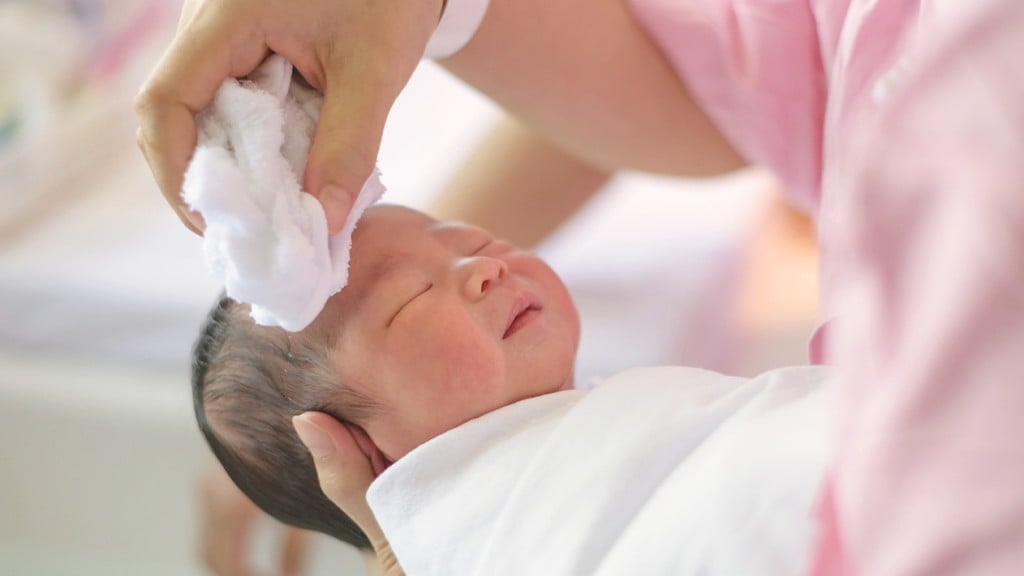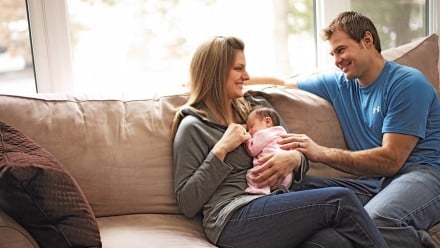
It’s true: Your baby is absolutely beautiful and probably the sweetest tiny human ever born, but even the most stunning infants need a bit of grooming now and then. And, as you’ve figured out by now, newborns don’t come with manuals, so we’ve rounded up some expert tips for keeping your baby looking (and feeling!) her best.
Caring for the umbilical cordThis remarkable organ that kept him nourished throughout pregnancy has a bit of an ick factor outside the womb when you’re waiting for it to dry and fall off, which usually takes one to two weeks. At each diaper change, gently wipe the tummy area clean with warm water, allowing the cord itself to stay dry. Avoid tucking it inside the diaper, which Michelle Ponti, a pediatrician in London, Ont., says could trap moisture and make the area “quite dirty and stinky pretty quick.” If you notice any smell, redness, swelling, puss, or if your baby seems feverish or irritable, contact your healthcare provider.
During a bath, it’s OK if the cord gets a little wet as long as you allow it to air-dry afterward, says pediatric naturopath Hillary Dining from Calgary. And be mindful not to knock or hit the sensitive area by accident.
Bathing
Hold off on giving your baby a bath for about the first week of life. Most newborn skin is covered in a creamy, white substance called the vernix caseosa, which is largely made up of oils from a baby’s sweat glands. This layer acts as a barrier, protecting your baby’s skin in utero. After birth, Dinning says this natural coating continues to ward off bacteria while keeping your baby’s sensitive skin healthy and moisturized. Within five to 10 days, the vernix will slough off on its own, and that’s a good time to give your baby her first bath. In the first month of life, Ponti says a sponge bath (versus a dunk in the sink or tub) is all your baby needs to stay fresh and clean. Wash your baby’s body with a soft cloth dipped in warm water, using soap only when needed (e.g. after a messy spit-up or challenging diaper change) up to three times a week. (You may also need to clean up other small messes from feeding and changing in between.) Once you start giving your baby more immersive baths after that first month, one to three times per week is enough to keep them clean. Ponti recommends unscented soap that’s specially formulated for babies. Remember that baby-formulated soaps don’t lather well, so “don’t keep dumping more and more of it into the water, expecting bubbles,” explains Ponti.
Hold off on giving your baby a bath for about the first week of life. Most newborn skin is covered in a creamy, white substance called the vernix caseosa, which is largely made up of oils from a baby’s sweat glands. This layer acts as a barrier, protecting your baby’s skin in utero. After birth, Dinning says this natural coating continues to ward off bacteria while keeping your baby’s sensitive skin healthy and moisturized. Within five to 10 days, the vernix will slough off on its own, and that’s a good time to give your baby her first bath. In the first month of life, Ponti says a sponge bath (versus a dunk in the sink or tub) is all your baby needs to stay fresh and clean. Wash your baby’s body with a soft cloth dipped in warm water, using soap only when needed (e.g. after a messy spit-up or challenging diaper change) up to three times a week. (You may also need to clean up other small messes from feeding and changing in between.) Once you start giving your baby more immersive baths after that first month, one to three times per week is enough to keep them clean. Ponti recommends unscented soap that’s specially formulated for babies. Remember that baby-formulated soaps don’t lather well, so “don’t keep dumping more and more of it into the water, expecting bubbles,” explains Ponti.
GenitalsWhen washing, treat your baby’s genitals like any other body part in the bath by gently rinsing the area with warm waterfront to back for girls to avoid spreading bacteria. Ponti says to pat the baby dry post-bath to prevent his skin from getting cold, then allow the skin to air-dry fully before applying a barrier cream (only when you notice he’s a little red from diaper rash) or a diaper. She also strongly cautions against baby powder to help dry your baby’s genitals—or for any other purpose—as the fine dust can easily travel into your baby’s lungs.
If your son has been circumcised, carefully bathe him in warm water every day for a full week after surgery. Following each bath, apply a layer of petroleum jelly to the end of the penis to protect it from the diaper while it is sensitive and healing. Continue applying this topical barrier after every bath and diaper change until he’s healed completely, usually within 10 days.
SkinIt’s true—your baby’s skin is already perfectly soft, but Ponti recommends applying a baby-friendly lotion on a regular basis to keep their skin hydrated, “allowing it to act as a good barrier against infection.” Dry patches are also prone to cracking, which can make the area vulnerable to bacteria or fungus.
At around two to four weeks of age, it’s very common for babies to develop a rash of acne across their face—little pimples covering her cheeks, nose, forehead, and chin. They can even spread to the body. They’re caused by mom’s hormones still circulating in the baby’s body, so there’s nothing you can do to prevent it. But don’t panic, this ugly duckling stage is temporary and will resolve itself in two to six weeks. “It may be tempting to pick at it or wash it or put creams on it,” says Dinning, adding there are not many parents can do to speed up the process. Just gently clean their face with warm water at bath time, and never pick at the pimples which could delay healing. However, see your healthcare provider if the rash worsens over time as it could be an allergy, eczema or a symptom of something more serious.
ScalpNot only do parents and caregivers need to be mindful of fontanelles—soft spots on an infant’s head where the skull bones haven’t fused together yet—the skin on a baby’s scalp is also very delicate and can scratch easily. Avoid scrubbing the scalp too vigorously while shampooing your baby’s hair, and look out for cradle cap—waxy spots that often form on a baby’s head. Opinions differ on why babies develop these spots—they may be another reaction to Mom’s hormones or a form of fungal infection. But they’re very common in babies three months old and up. While cradle cap is generally self-resolving—the spots flake off on their own within a few months—parents can help to loosen the spots by moistening their baby’s head with water or olive oil, then gently encouraging the scales to lift using a soft brush or cloth. Because cradle cap scales can become itchy for some babies, Dining advises applying a moisturizing layer of shea butter or coconut oil after a bath.
Don’t worry about shampooing your baby’s hair too often. Whether he has a luxurious mane or just a few sprouts, Ponti says a gentle massage with unscented, baby-formulated shampoo is all he needs no more than a few times per week. If his hair needs to be detangled, use a brush for babies with extra soft bristles to avoid irritating the scalp.

The first four weeks: what caring for a newborn is really likeNailsNot only do they look tidier, trimmed fingernails and toenails are also safer for babies. Dinning says they can scratch themselves, especially very young infants who haven’t figured out how to control their hands. Because adult-sized clippers make it difficult to see whether you’re cutting nail or skin, baby clippers are recommended to avoid hurting your baby. Round out any edges with a baby nail file to remove sharp points, and if clippers make you nervous, Ponti says just filing the nails down is fine until your child is a little older. Though some parents try biting nails, this is not recommended because you can spread bacteria or break the skin.
EarsYour baby’s ears, like your own, will clean themselves naturally—no cotton swab needed. “We all have that urge to go digging around in the ear canal, but that’s the wrong thing to do,” says Ponti. You can use a warm washcloth to wipe away any obvious drainage around the external ear area but leave the inner ear alone. Even if you do manage to pull some ear wax out of the inner ear with a cotton swab, you’ll still risk pushing more in.
EyesWe all get a little crust or goo in our eyes now and then. Ponti says the best way to remove it is to soak a baby cloth or cotton ball with clean water and gently dab the eye area, starting from the inner corner of the eye (closest to the nose) and working towards the outer corner. Because cold and flu viruses can cause conjunctivitis, also known as pink eye, if you’re sick, wash your hands before handling your baby. Watch for eye discharge or redness, which could signal a pink eye, or a more serious infection, both of which should be seen by your healthcare provider.
MouthWith their sweet baby breath, it’s hard to believe bacteria are setting up camp in your infant’s mouth even before teeth arrive, but it’s important to keep her gums clean and healthy by gently wiping them daily with a clean, damp cloth. Once teeth arrive, give them a brush every day with a soft toothbrush designed for babies, which Ponti says will both keep her new teeth healthy and establish good oral hygiene habits. But don’t worry about using kid-friendly (fluoride-free) toothpaste until your baby turns one as they’re likely to swallow most of it.
Caring for yourselfEven simple tasks like filing nails can overwhelm an exhausted parent, so if you’re overtired or not feeling confident, just wait until you’re ready, or have an extra pair of hands to help. “That bath can always wait,” says Ponti. Start any grooming task by placing all the supplies you need within reach—especially at bath time to keep one hand on the baby—so you can feel comfortable and calm throughout the task, and keep your baby safe.

No comments:
Post a Comment